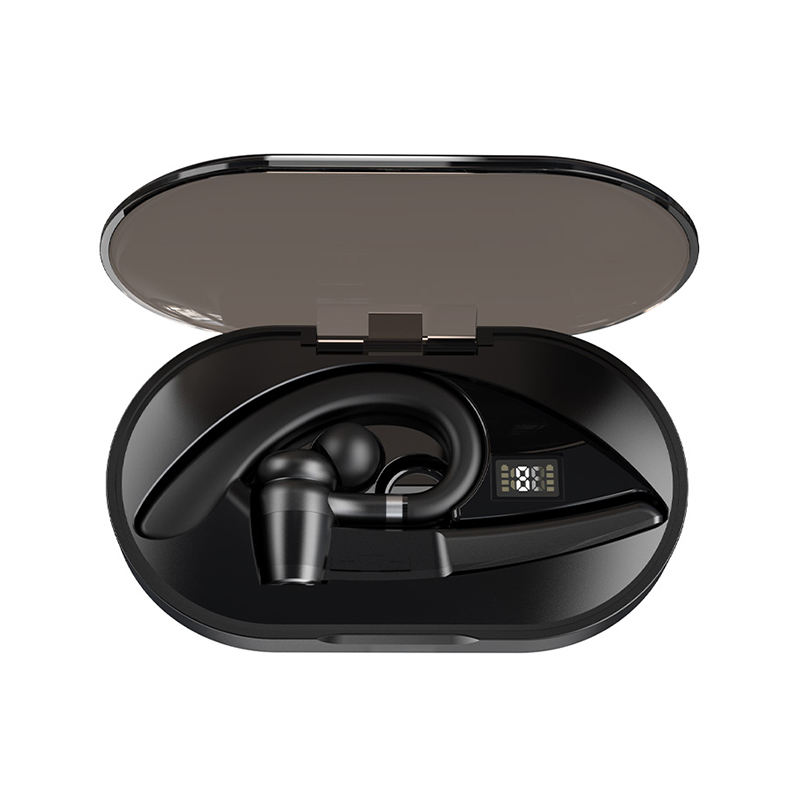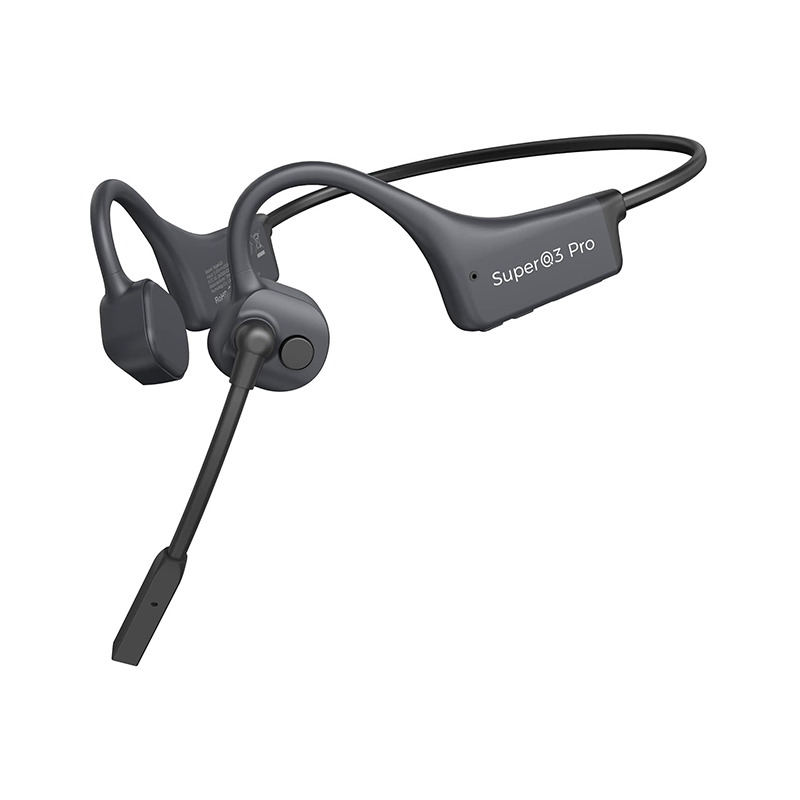How does the active noise cancellation feature of a Bluetooth business headset perform in noisy environments?
Release Time : 2025-08-27
The active noise cancellation feature of a Bluetooth business headset plays an increasingly critical role in the modern mobile workplace. As work boundaries continue to expand, professionals frequently travel between airports, high-speed trains, shared office spaces, and the streets. These environments are filled with constant low-frequency noise—the roar of airplane engines, the vibration of subway tracks, the hum of air conditioning systems, and even the clamor of crowds. These sounds not only disrupt concentration but also invisibly increase auditory fatigue, affecting communication efficiency and decision-making quality. Active noise cancellation technology was developed to address this challenge. Using acoustic principles and intelligent algorithms, it proactively interferes with the propagation path of external noise, creating a relatively quiet listening environment for users.
Its working principle isn't simply to block sound, but rather to leverage the physical property of "sound wave cancellation." The headset's built-in microphone captures external ambient noise in real time. The chip rapidly analyzes its frequency and waveform, generating a counter-current sound wave with opposite phase and equal amplitude. When the original noise and the counter-waves meet in the ear canal, they cancel each other out, significantly reducing the noise energy in a specific frequency band. This process occurs continuously within milliseconds, forming a dynamic "silence barrier." Active noise cancellation performs exceptionally well for low-frequency, steady, and highly cyclical noise, such as traffic noise, significantly reducing auditory oppression and enabling users to think clearly or focus on reading while traveling.
In real-world business scenarios, this noise cancellation capability translates into tangible efficiency gains. During a cross-border conference call, even in a bustling airport, the wearer can still clearly hear the other party, avoiding frequent confirmations or misunderstandings due to environmental interference. During long-distance business trips, noise cancellation can help alleviate travel stress, improve rest quality, and conserve energy for intense work upon arrival. In open offices, users can use noise cancellation mode to block out surrounding keyboard tapping, phone ringing, and idle chatter, allowing them to enter a deeper work state and improve task completion efficiency.
However, noise cancellation is not always effective. Its ability to suppress high-frequency, sudden, or irregular noise is limited. For example, sudden shouts, breaking glass, or conversations with neighbors, due to their complex waveforms and instantaneous changes, are difficult for systems to detect and mitigate in a timely manner. Therefore, modern business headsets often combine passive noise isolation—blocking some high-frequency sounds through the physical seal of the earbuds—to create a hybrid noise reduction solution for more comprehensive noise management.
Furthermore, many high-end business headsets offer adjustable noise reduction levels, allowing users to choose between strong, standard, or light modes based on environmental intensity and personal preference. Some products also feature intelligent sensing, automatically identifying the environment and dynamically adjusting noise reduction strategies to ensure the optimal listening experience in every scenario.
It is important to note that noise reduction does not come at the expense of communication. Most business headsets support an ambient sound pass-through mode, allowing users to clearly hear surrounding sounds without removing the headset, making it convenient for conversing with colleagues, passing through security, or listening to announcements. This flexible shift between "isolation" and "connection" demonstrates technology's deep understanding of human needs.
The stability of active noise reduction also depends on the fit of the headset. The seal between the earbud and the ear canal directly impacts noise cancellation effectiveness. Improper fit can cause sound leakage and weaken noise cancellation. Therefore, manufacturers typically offer earbud tips in multiple sizes to help users find the optimal fit.
In summary, the active noise cancellation feature of a Bluetooth business headset demonstrates significant practical value in noisy environments. It's not just a demonstration of technology; it's a practical concern for the auditory health and productivity of modern professionals. When external noise is quietly filtered out, focus is restored, and every call and every thought is given the respect it deserves in silence.
Its working principle isn't simply to block sound, but rather to leverage the physical property of "sound wave cancellation." The headset's built-in microphone captures external ambient noise in real time. The chip rapidly analyzes its frequency and waveform, generating a counter-current sound wave with opposite phase and equal amplitude. When the original noise and the counter-waves meet in the ear canal, they cancel each other out, significantly reducing the noise energy in a specific frequency band. This process occurs continuously within milliseconds, forming a dynamic "silence barrier." Active noise cancellation performs exceptionally well for low-frequency, steady, and highly cyclical noise, such as traffic noise, significantly reducing auditory oppression and enabling users to think clearly or focus on reading while traveling.
In real-world business scenarios, this noise cancellation capability translates into tangible efficiency gains. During a cross-border conference call, even in a bustling airport, the wearer can still clearly hear the other party, avoiding frequent confirmations or misunderstandings due to environmental interference. During long-distance business trips, noise cancellation can help alleviate travel stress, improve rest quality, and conserve energy for intense work upon arrival. In open offices, users can use noise cancellation mode to block out surrounding keyboard tapping, phone ringing, and idle chatter, allowing them to enter a deeper work state and improve task completion efficiency.
However, noise cancellation is not always effective. Its ability to suppress high-frequency, sudden, or irregular noise is limited. For example, sudden shouts, breaking glass, or conversations with neighbors, due to their complex waveforms and instantaneous changes, are difficult for systems to detect and mitigate in a timely manner. Therefore, modern business headsets often combine passive noise isolation—blocking some high-frequency sounds through the physical seal of the earbuds—to create a hybrid noise reduction solution for more comprehensive noise management.
Furthermore, many high-end business headsets offer adjustable noise reduction levels, allowing users to choose between strong, standard, or light modes based on environmental intensity and personal preference. Some products also feature intelligent sensing, automatically identifying the environment and dynamically adjusting noise reduction strategies to ensure the optimal listening experience in every scenario.
It is important to note that noise reduction does not come at the expense of communication. Most business headsets support an ambient sound pass-through mode, allowing users to clearly hear surrounding sounds without removing the headset, making it convenient for conversing with colleagues, passing through security, or listening to announcements. This flexible shift between "isolation" and "connection" demonstrates technology's deep understanding of human needs.
The stability of active noise reduction also depends on the fit of the headset. The seal between the earbud and the ear canal directly impacts noise cancellation effectiveness. Improper fit can cause sound leakage and weaken noise cancellation. Therefore, manufacturers typically offer earbud tips in multiple sizes to help users find the optimal fit.
In summary, the active noise cancellation feature of a Bluetooth business headset demonstrates significant practical value in noisy environments. It's not just a demonstration of technology; it's a practical concern for the auditory health and productivity of modern professionals. When external noise is quietly filtered out, focus is restored, and every call and every thought is given the respect it deserves in silence.







